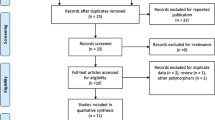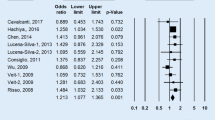Abstract
Objective
The aim of this study was to determine whether the major histocompatibility complex class I chain-related gene A transmembrane (MICA-TM) polymorphism is associated with susceptibility to systemic lupus erythematous (SLE), rheumatoid arthritis (RA) and ankylosing spondylitis (AS).
Methods
A meta-analysis was conducted to establish the association between MICA-TM polymorphisms and SLE, RA and AS in the overall study population, as well as in each ethnic group.
Results
A total of 13 comparison studies, including five SLE (1601 patients; 1846 controls), four RA (701 patients; 887 controls) and four AS (346 patients; 356 controls) studies were considered in the meta-analysis. An association between the MICA-TM A5.1 allele and SLE was demonstrated in Europeans but not in Asians: odds ratio (OR) = 1.699, 95 % confidence interval (CI) = 1.123–2.569, p = 0.012 and OR = 0.949, 95 % CI = 0.502–1.793, p = 0.871, respectively. However, no association was found in Europeans after Bonferroni correction (pcorrected = 0.060). An association was found between the MICA-TM A9 allele and RA in Asians (OR = 0.527, 95 % CI = 0.408–0.681, p = 8.9 × 10−7) but not in Europeans; the association in Asians remained significant after Bonferroni correction (pcorrected = 4.5 × 10−6). An association between the MICA-TM A4 phenotype and AS was observed in European and Asian populations (OR = 12.87, 95 % CI = 6.747–24.58, p < 1.0 × 10−9 and OR = 9.461, 95 % CI = 5.754–15.55, p < 1.0 × 10−9, respectively). Meta-analysis stratified by human leukocyte antigen (HLA)-B27 status revealed an association between the MICA-TM A4 phenotype and HLA-B27 positivity AS in Asians, but not in Europeans (OR = 0.318, 95 % CI = 0.102–0.995, p = 0.049 and OR = 2.080, 95 % CI = 0.422–10.25, p = 0.368, respectively). However, the association in Asians was not significant after Bonferroni correction (pcorrected = 0.245).
Conclusion
This meta-analysis demonstrated that there was no association between MICA-TM polymorphisms and SLE susceptibility, but that the MICA-TM A9 allele was associated with an RA risk in Asians. Moreover, the association between the MICA-TM A4 phenotype and AS was HLA-B27-dependent.
Zusammenfassung
Ziel
Ziel der vorliegenden Studie war zu untersuchen, ob der MICA-TM-Polymorphismus (MICA: „major histocompatibility complex class I chain-related gene A“, MHC-Klasse-I-assoziiertes Gen A; TM-: Transmembran-) mit der Anfälligkeit für systemischen Lupus erythematodes (SLE), rheumatoide Arthritis (RA) und ankylosierende Spondylitis (AS) in Zusammenhang steht.
Methoden
Es wurde eine Metaanalyse durchgeführt, um den Zusammenhang zwischen MICA-TM-Polymorphismen und SLE, RA sowie AS sowohl in der gesamten Studienpopulation als auch in den einzelnen ethnischen Gruppen zu untersuchen.
Ergebnisse
In der Metaanalyse wurden 13 Vergleichsstudien, davon 5 zu SLE (1601 Patienten, 1846 Kontrollen), 4 zu RA (701 Patienten, 887 Kontrollen) und 4 zu AS (346 Patienten, 356 Kontrollen) ausgewertet. Ein Zusammenhang zwischen dem MICA-TM-A5.1-Allel und SLE wurde bei Europäern, nicht aber bei Asiaten festgestellt: Odds Ratio (OR): 1,699; 95%-Konfidenzintervall (95%-KI): 1,123–2,569; p = 0,012 bzw. OR: 0,949; 95%-KI: 0,502–1,793; p = 0,871. Jedoch bestand kein Zusammenhang für Europäer nach Bonferroni-Korrektur (pcorrected = 0,060). Zwischen dem MICA-TM-A9-Allel und RA wurde bei Asiaten (OR: 0,527; 95%-KI: 0,408–0,681; p = 8,9 × 10−7), nicht aber bei Europäern ein Zusammenhang nachgewiesen; der Zusammenhang blieb auch nach Bonferroni-Korrektur signifikant (pcorrected = 4,5 × 10−6). Einen Zusammenhang gab es zwischen dem MICA-TM-A4-Phänotyp und AS in europäischen und asiatischen Populationen (OR: 12,87; 95%-KI: 6,747–24,58; p < 1,0 × 10−9 bzw. OR: 9,461; 95%-KI: 5,754–15,55; p < 1,0 × 10−9). Bei Stratifizierung der Metaanalyse gemäß dem Status beim humanen Leukozytenantigen (HLA-)B27 zeigte sich ein Zusammenhang zwischen dem MICA-TM-A4-Phänotyp und HLA-B27-Positivität bei AS für Asiaten, nicht aber für Europäer (OR: 0,318; 95%-KI: 0,102–0,995; p = 0,049 bzw. OR: 2,080; 95%-KI: 0,422–10,25; p = 0,368). Allerdings war der Zusammenhang bei Asiaten nach Bonferroni-Korrektur nicht signifikant (pcorrected = 0,245).
Schlussfolgerung
Diese Metaanalyse hat gezeigt, dass es zwar keinen Zusammenhang zwischen MICA-TM-Polymorphismen und SLE-Anfälligkeit gab, aber dass das MICA-TM-A9-Allel mit einem RA-Risiko bei Asiaten assoziiert war. Darüber hinaus war der Zusammenhang zwischen dem MICA-TM-A4-Phänotyp und AS vom HLA-B27-Status abhängig.
Similar content being viewed by others
References
Lee YH, Nath SK (2005) Systemic lupus erythematosus susceptibility loci defined by genome scan meta-analysis. Hum Genet 118:434–443
Choi SJ, Rho YH, Ji JD et al (2006) Genome scan meta-analysis of rheumatoid arthritis. Rheumatology (Oxford) 45:166–170
Lee YH, Rho YH et al (2005) Ankylosing spondylitis susceptibility loci defined by genome-search meta-analysis. J Hum Genet 50:453–459
Groh V, Steinle A, Bauer S, Spies T (1998) Recognition of stress-induced MHC molecules by intestinal epithelial gammadelta T cells. Science 279:1737–1740
Zwirner NW, Fernandez-Vina MA, Stastny P (1998) MICA, a new polymorphic HLA-related antigen, is expressed mainly by keratinocytes, endothelial cells, and monocytes. Immunogenetics 47:139–148
Rueda B, Pascual M, Lopez-Nevot MA et al (2002) A new allele within the transmembrane region of the human MICA gene with seven GCT repeats. Tissue Antigens 60:526–528
Mizuki N, Ota M, Kimura M et al (1997) Triplet repeat polymorphism in the transmembrane region of the MICA gene: a strong association of six GCT repetitions with Behcet disease. Proc Natl Acad Sci U S A 94:1298–1303
Yoshida K, Komai K, Shiozawa K et al (2011) Role of the MICA polymorphism in systemic lupus erythematosus. Arthritis Rheum 63:3058–3066
Fojtikova M, Novota P, Cejkova P et al (2011) HLA class II, MICA and PRL gene polymorphisms: the common contribution to the systemic lupus erythematosus development in Czech population. Rheumatol Int 31:1195–1201
Sanchez E, Torres B, Vilches JR et al (2006) No primary association of MICA polymorphism with systemic lupus erythematosus. Rheumatology (Oxford) 45:1096–1100
Gambelunghe G, Gerli R, Bocci EB et al (2005) Contribution of MHC class I chain-related A (MICA) gene polymorphism to genetic susceptibility for systemic lupus erythematosus. Rheumatology (Oxford) 44:287–292
Ban G, Chu J, Mao C et al (2002) A study of the relationship between MICA gene and systemic lupus erythematosus. Zhonghua Yi Xue Yi Chuan Xue Za Zhi 19:298–301
Lopez-Arbesu R, Ballina-Garcia FJ, Alperi-Lopez M et al (2007) MHC class I chain-related gene B (MICB) is associated with rheumatoid arthritis susceptibility. Rheumatology (Oxford) 46:426–430
Mok JW, Lee YJ, Kim JY et al (2003) Association of MICA polymorphism with rheumatoid arthritis patients in Koreans. Hum Immunol 64:1190–1194
Singal DP, Li J, Zhang G (2001) Microsatellite polymorphism of the MICA gene and susceptibility to rheumatoid arthritis. Clin Exp Rheumatol 19:451–452
Ricci-Vitiani L, Vacca A, Potolicchio I et al (2000) MICA gene triplet repeat polymorphism in patients with HLA-B27 positive and negative ankylosing spondylitis from Sardinia. J Rheumatol 27:2193–2197
Yabuki K, Ota M, Goto K et al (1999) Triplet repeat polymorphism in the MICA gene in HLA-B27 positive and negative caucasian patients with ankylosing spondylitis. Hum Immunol 60:83–86
Goto K, Ota M, Ohno S et al (1997) MICA gene and ankylosing spondylitis: linkage analysis via a transmembrane-encoded triplet repeat polymorphism. Tissue Antigens 49:503–507
Lee YH, Harley JB, Nath SK (2006) Meta-analysis of TNF-alpha promoter -308 A/G polymorphism and SLE susceptibility. Eur J Hum Genet 14:364–371
Nath SK, Harley JB, Lee YH (2005) Polymorphisms of complement receptor 1 and interleukin-10 genes and systemic lupus erythematosus: a meta-analysis. Hum Genet 118:225–234
Lee YH, Rho YH, Choi SJ et al (2006) Association of TNF-alpha -308 G/A polymorphism with responsiveness to TNF-alpha-blockers in rheumatoid arthritis: a meta-analysis. Rheumatol Int 27:157–161
Davey Smith G, Egger M (1997) Meta-analyses of randomised controlled trials. Lancet 350:1182
Egger M, Smith GD, Phillips AN (1997) Meta-analysis: principles and procedures. BMJ 315:1533–1537
DerSimonian R, Laird N (1986) Meta-analysis in clinical trials. Control Clin Trials 7:177–188
Higgins JP, Thompson SG (2002) Quantifying heterogeneity in a meta-analysis. Stat Med 21:1539–1558
Egger M, Davey Smith G, Schneider M, Minder C (1997) Bias in meta-analysis detected by a simple, graphical test. BMJ 315:629–634
Zhou X, Wang J, Zou H et al (2013) MICA, a gene contributing strong susceptibility to ankylosing spondylitis. Ann Rheum Dis
Su H, Wang BL, Zhang XJ et al (2006) Disequilibrium linkage between the polymorphism in exons 2, 3 and 4 of the MICA gene and HLA-B antigen of patient with ankylosing spondylitis. Zhonghua Yi Xue Yi Chuan Xue Za Zhi 23:446–448
Martinez-Borra J, Gonzalez S, Lopez-Vazquez A et al (2000) HLA-B27 alone rather than B27-related class I haplotypes contributes to ankylosing spondylitis susceptibility. Hum Immunol 61:131–139
Fang M, Chen R, Cai Q et al (2007) Association of HLA genes with ankylosing spondylitis in Han population of eastern China. Scand J Immunol 65:559–566
Kirsten H, Petit-Teixeira E, Scholz M et al (2009) Association of MICA with rheumatoid arthritis independent of known HLA-DRB1 risk alleles in a family-based and a case control study. Arthritis Res Ther 11:R60
Bahram S, Bresnahan M, Geraghty DE, Spies T (1994) A second lineage of mammalian major histocompatibility complex class I genes. Proc Natl Acad Sci U S A 91:6259–6263
Groh V, Bahram S, Bauer S et al (1996) Cell stress-regulated human major histocompatibility complex class I gene expressed in gastrointestinal epithelium. Proc Natl Acad Sci U S A 93:12445–12450
Tonnerre P, Gerard N, Chatelais M, Charreau B (2010) MICA gene polymorphism in kidney allografts and possible impact of functionally relevant variants. Transplant Proc 42:4318–4321
Acknowledgements
This study was supported in part by a grant of the Korea Healthcare technology R&D project, Ministry for Health & Welfare, Republic of Korea (HI12C1834).
Compliance with ethical guidelines
Conflict of interest. Y.H. Lee, S.-C. Bae, J.-H. Kim and G.G. Song state that there are no conflicts of interest. The accompanying manuscript does not include studies on humans or animals.
Author information
Authors and Affiliations
Corresponding author
Rights and permissions
About this article
Cite this article
Lee, Y., Bae, SC., Kim, JH. et al. Meta-analysis of the association between functional MICA-TM polymorphisms and systemic lupus erythematosus, rheumatoid arthritis and ankylosing spondylitis. Z. Rheumatol. 74, 146–152 (2015). https://doi.org/10.1007/s00393-014-1409-9
Published:
Issue Date:
DOI: https://doi.org/10.1007/s00393-014-1409-9
Keywords
- HLA-B27 antigen
- Major histocompatibility complex
- Autoimmune disease
- Ethnic groups
- Genetic association studies




